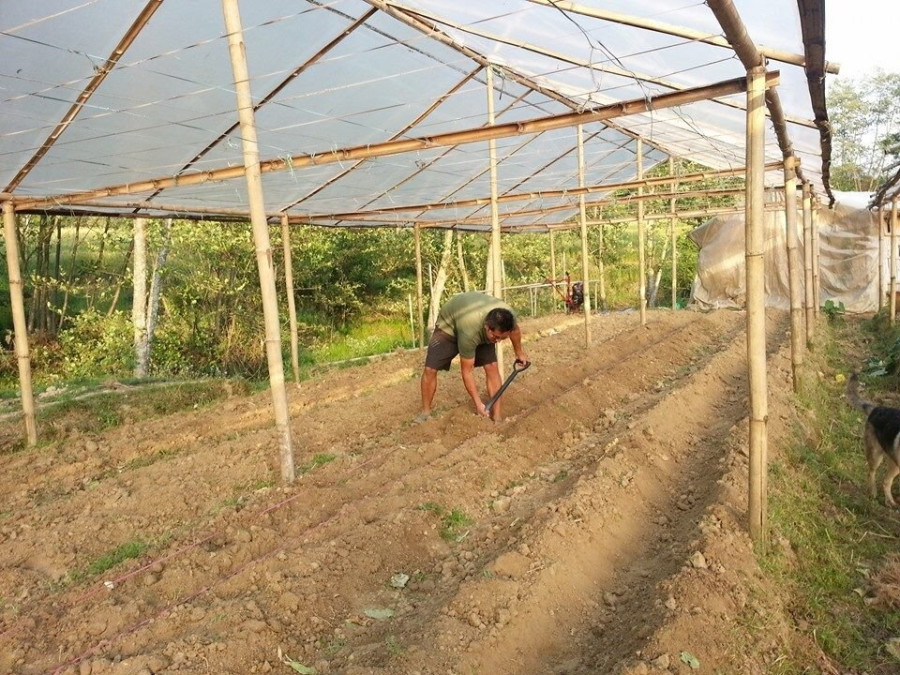Money
Pandemic-hit youth entrepreneurs complain about lack of government support
According to the Central Bureau of Statistics, 54.5 percent of all establishments in the country are owned by young people.
Krishana Prasain
Former migrant worker Sujan Kumar Shrestha established a vegetable farm after returning from Dubai in 2013 when he was 30 years old. It has been nine years since he started the farm with borrowed capital, but the operation challenges he is facing sometimes make him feel that he should have stayed abroad for a few more years.
“We do not get seedlings, pesticides and fertilisers on time which directly impacts production and income. The government announces different programmes and subsidies in agriculture in the budget statement annually, but I have not benefited from any of these farmer-targeted programmes,” said Shrestha whose vegetable farm in Ramkot is spread over 28 ropanis of lease land for which he has to pay an annual rent of Rs20,000 per ropani.
“During the lockdowns last year and this year, I suffered huge losses after not being able to take my products to market on time,” he said.
Aditya Singh always dreamed of starting something of his own instead of doing a nine-to-five job. But he found out the hard way that things don't happen as planned.
Singh, 32, had wanted to open a travel company and operate tour packages for domestic and international tourists after completing his Master’s in business studies. For capital, he applied for a loan under a government loan scheme which allows young entrepreneurs to obtain credit by using their academic certificate as collateral.
"But banks do not provide loans unless they see a profit," said Singh. “I applied for a loan some six-seven months ago, but I have not heard anything since then.”
August 12 is celebrated as International Youth Day. This year's theme is "Transforming Food Systems: Youth Innovation for Human and Planetary Health" that highlights that the success of such a global effort will not be achieved without the meaningful participation of young people.
Youth entrepreneurs like Shrestha and Singh have not felt the presence of the state, neither before the pandemic nor now.
Last year, the government apprehended e-commerce entrepreneurs for delivering goods to people's homes during the lockdown, ordering them to cease operations while the stay-home order was in effect.
During the recent lockdown, e-commerce businesses were provided a small window to make deliveries even though home delivery is being seen around the world as one of the safest ways to buy goods amid the Covid-19 pandemic.
According to the Central Bureau of Statistics, 54.5 percent of all establishments in the country, or 450,464 out of the 923,356 firms, are owned by young entrepreneurs. But entrepreneurship has never been easy in the country due to lack of skill, capacity and entrepreneurship oriented programmes, bewildering paperwork and difficult access to finance, said entrepreneurs.
The government has announced that grants and subsidised loans will be provided, but startup entrepreneurs complain that they have never been able to get the facilities mentioned in the budget statement.
A provision for providing credit at subsidised interest had been included in the previous year's budget statement, but it did not happen for certain reasons.
The budget for the fiscal year 2021-22 announced issuing Rs2.5 million in seed capital at 1 percent interest against the project as collateral to encourage youth entrepreneurs to engage in startup businesses.
The government has allocated Rs1 billion to provide subsidised loans to startups which will be issued as per the Business Credit Flow Work Procedure 2021 prepared by the Ministry of Finance.
Actual data does not exist, but according to a startup industry insider estimate, about 25 percent of startups have folded since the pandemic began. Youth entrepreneurs say that the business environment is definitely not positive for startup entrepreneurs who are facing challenges due to lockdowns imposed in different countries, and the current political instability which has made the situation worse.
The government announced the loan scheme with no proper planning, and it is not being implemented due to which entrepreneurs have not benefited from it. Nobody knows anything about the programmes the government says it has launched, said entrepreneurs.
Kavi Raj Joshi, founder and managing director of Next Venture Crop, said that a majority of young entrepreneurs of the country are in debt, and it has become difficult for them to rise due to the problems created by Covid-19.
“We do not have a national agenda as youth entrepreneurs to achieve the common goals,” he said.
The country lacks national level mechanisms that channelise the youth's contribution to the national economy. “Observing the environment in the country and the situation created by the pandemic, youths in their 20s and 30s have started fearing that their prime years will pass doing nothing,” he said.
Economist Bishwambhar Pyakurel said that countries do not lack a productive age group, but the contribution of the youth force in Nepal's economy is less as the government has failed to create such an environment.
"If the government is able to retain and expand the business created by youth, it will be beneficial in many ways," he said. "Based on the project quality, the business proposal they submit for the loan and their vision, a project loan can be provided by forming a government committee, and banks should have a department that can assure the feasibility of the proposed business," he added.
"The government should look at the underlying factors that limit access to loans to prospective young entrepreneurs. The government should provision access to credit and access to potential employment opportunities, explore the employment generating sector and aggressively move ahead in capacity and skill development of youth for their productivity to make an economic contribution,” Pyakurel said.
"Unfortunately, the government has not done its homework to mobilise the youth force for its participation in income generation by identifying potential sectors."
As per official data, 84.6 percent of the labour force is engaged in the informal sector, and the potential age group goes abroad as migrant workers.
Among the 15-29 age group, 19.2 percent or nearly 5.76 million persons are unemployed. The average national employment rate is 2.7 percent.
More than 70 percent of the income of migrant returnees goes for consumption while 30 percent goes to the productive and unproductive sectors. The income earned from remittance has not been able to form capital.
“There is not much contribution of the youth productive force in Nepal's economy as the government has failed to create that environment,” Pyakurel said.
According to him, even the middle-class population hardly has access to quality education. Due to outdated courses of study in the university system, there is no convergence between the demand of industrialists and the manpower produced by the education system, which is the biggest problem in employment and even in creating jobs.
“In the past one decade, the manufacturing sector was able to create employment for 1.18 percent of the population, or 3.5 million persons, which is very low compared to the number of people entering the job sector annually in the economy,” he said.
"There is not even a single identifiable project that is run on the basis of public-private partnership as 70 percent of the contribution in the national economy is from the private sector. The government can bring such projects to engage the youth population," he said.
The 16-40 age group is considered as the youth population in Nepal. According to the 2011 census, the total youth population in Nepal is 1.68 million which is 40.3 percent of the total population. Among the young population, 45.8 percent are males and 54.5 percent are females.
According to government estimates, nearly 500,000 young people enter the job market every year. The budget for the fiscal year aims to create less than 350,000 new jobs through its employment-related schemes and plans, which is down by half from the last fiscal year 2020-21, and also compared to the number of young people entering the job market annually.
For aspirant entrepreneur Singh, the pandemic has forced him to either look for a job or go abroad as a migrant worker, as he is financially incapable of starting a business of his own. “My parents are getting old, and I have no option other than to look for a job and settle down.”




 6.94°C Kathmandu
6.94°C Kathmandu















